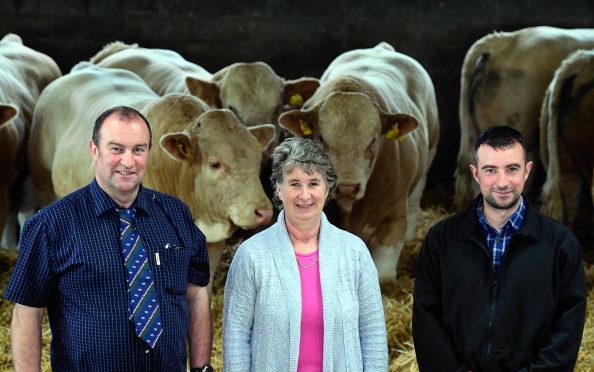The debate over whether or not cows are getting too big rumbled on at a farm open day near Laurencekirk.
The event, which was organised by SAC Consulting and funded by the government’s Farming for a Better Climate initiative, was held at Gerald, Morag and Douglas Smith’s Drumsleed Farm, by Fordoun.
Farmers attending the event were told of the benefits of weighing cows and calves, while a well-known Perthshire farmer argued the case for keeping smaller cows.
The Smiths, who run a prized pedigree herd of Simmentals and a commercial herd of Simmental cross cows at Drumsleed, aim to calve down all commercial heifers at two years old.
SAC beef and sheep specialist Kirsty Williams said sexual maturity in cattle was related to weight, and not age, so farmers aiming to calf heifers at two needed to keep a close eye on their weight.
“To calve at 24 months it is essential the animal has reached 65% of her mature weight at bulling, which is 15-16 months old,” said Mrs Williams.
At Drumsleed the average weight of mature commercial cows, aged between four and 15 years old, is 716kg. This means the family should aim to have bulling heifers, aged 15-months-old, weighing 465.4kg, which equates to a daily liveweight gain from birth of 0.94kg a day and a 24-month-old weight of 609kg.
The actual average weights achieved at Drumsleed are 513kg at bulling equating to a daily liveweight gain from birth of 1.05kg a day and a 24-month-old weight of 598kg.
Mrs Williams said farmers opting to go down the route of calving at two-years-old needed to give the heifers special treatment after they calved so they could “grow, milk and be fertile”. She said heifers were likely to be 85% of their mature weight at two-years-old.
On the issue of cow size, Mrs Williams said a quick calculation looking at the cost of keeping bigger cows over the winter suggested a herd of 100 cows averaging 850kg each would cost £1,620 more to feed than 100 cows averaging 650kg.
“As the cows get bigger, they need more maintenance,” she said.
This was backed by Perthshire farmer Adrian Ivory who keeps 250 cows at Strathisla Farms, near Meigle.
Mr Ivory said the farm’s 160 commercial cattle were all calved between 22 and 24-months-old and weighed on a regular basis. “If you don’t weigh, you can’t measure and if you can’t measure you can’t manage. It does not cost a lot to buy a set of weigh-scales and you will probably get your money back in six months,” he said.
He said he had measured the efficiency of his cows last year using gross feed over margin as a barometer for performance, and the smaller cows had come out on top.
Mr Ivory said the top third of the herd achieved £750, while the bottom third achieved £620.
When this was related back to the weight of the cows, the highest gross margin recorded was achieved in cows weighing on average 700kg, with the lowest gross margin seen in cows weighing 770kg. In addition, the average gestation period for the lighter cows was 352 days, compared to 382 days for the heavier ones.
“They (lighter cows) also had the highest weaned calf weight at 354kg, compared to 325kg,” said Mr Ivory.










